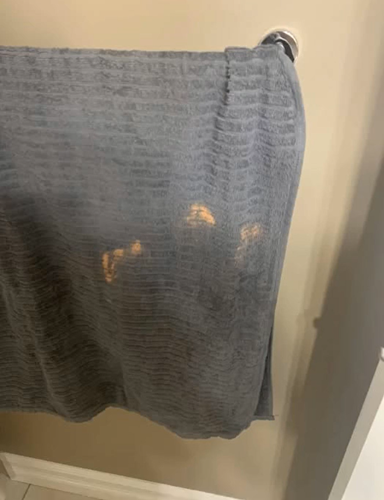
I still remember the morning I noticed it for the first time — a bright, almost fluorescent orange patch staring back at me from my favorite gray towel. The color looked so unnatural, like someone had brushed it with a highlighter. It completely threw me off. I assumed it was just a random spill or maybe a bit of rust from an old pipe or fixture. I didn’t think much of it and figured a good wash would take care of it.
So I tossed the towel in the washer, added extra detergent and stain remover, and waited. But when the cycle finished, that same orange spot was still there — just as vivid and impossible to miss. That’s when I realized it wasn’t going to be a quick fix.
Over the next few weeks, more towels began showing the same strange orange patches. Even pillowcases and some of my favorite shirts weren’t safe. My laundry started to look like someone had sprinkled orange paint across it. It was baffling — and annoying.
No matter what I did — soaking, scrubbing, or rewashing — the marks always came back. Determined to get to the bottom of it, I started researching everything I could about fabric discoloration. I read articles, scrolled through forums, and asked friends for advice. What I discovered completely changed how I care for my linens.
The biggest surprise? Those orange spots weren’t “stains” at all. The real culprit was benzoyl peroxide, a common ingredient in acne treatments and skincare products.
This chemical doesn’t actually add color to fabric — it removes it. It bleaches out the dye in the fibers, leaving behind orange or yellow patches that look like stains but are really spots where the color has been stripped away. That’s why regular cleaning or stain removers never worked — the damage was already done.
I also learned that benzoyl peroxide isn’t the only cause. Water with high iron content can also create rust-colored dots on fabric, especially in homes with well water or older plumbing. These iron deposits stick to the fibers, leaving behind orange-brown specks that can worsen over time. Unlike the large, pale patches caused by bleaching agents, iron stains usually appear as smaller, scattered spots.
Other hidden sources include hair products, self-tanners, tinted shampoos, and even certain cleaning sprays that contain peroxide-based ingredients. These can transfer onto towels or fabrics and cause discoloration once they dry.
Armed with this information, I started making small changes. I now keep separate towels just for skincare routines involving benzoyl peroxide and switched to white ones so any bleaching is barely noticeable. I also make sure to let products dry completely before touching any towels or clothing.
For hair treatments or other products that might stain, I use older towels I don’t mind damaging. Installing a water filter to lower the iron content in my water also helped keep new stains from appearing.
Over time, I even learned how to “read” the marks. Large, uneven orange patches usually mean bleaching from peroxide. Tiny, rusty dots often signal iron or minerals in the water. Unfortunately, once the color is gone, there’s no way to bring it back. When that happens, I repurpose those towels for cleaning, dye them darker, or fully bleach them to create a fresh, uniform look — no waste, no frustration.
Since learning all this, I’ve stopped constantly replacing my towels. The mystery that used to drive me crazy now makes sense. Whenever I spot an orange patch, I know exactly what caused it and how to prevent it from happening again.
Sometimes the key to fixing a problem isn’t scrubbing harder — it’s simply understanding why it happens. Once you do, even something as strange as orange towel stains becomes just another lesson learned.



